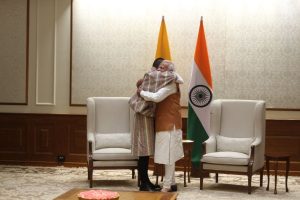Bhutan’s newly elected Prime Minister Tshering Tobgay was on a five-day visit to India from March 14 to 18. It was his first foreign visit after assuming office in February 2024, following the parliamentary elections in January 2024.
Tobgay’s visit to India came against the backdrop of ongoing border talks between Bhutan and China, which has raised concerns among strategic hawks who warn that a Bhutan-China deal would represent India’s crucial loss in the Himalayas. Located in the foothills of the strategic Himalayas, Bhutan holds critical prominence in India’s border policy toward China.
Bhutan and China have held 25 rounds of border talks since 2016 and more than ten rounds of Expert Group Meetings to discuss a “Three-Step Roadmap” aimed at delimiting the border, undertaking surveys, and concluding final demarcation. As the two countries inch toward finding a final resolution to the border, India certainly has worries, as any agreement will directly affect India’s national security.
The Siliguri Corridor, also known as the “Chicken’s Neck,” is a narrow strip of land in India that connects the northeastern states to the rest of the country. Since the corridor is close to disputed areas between Bhutan and China, any resolution will force India to revisit its entire Himalayan security structure.
On the sidelines of these border talks, China is also aiming to establish diplomatic ties with Bhutan, which Bhutan has been able to resist in the last seven decades. What Bhutan faces is a classical dilemma of a “small state.”
Thus far, closer relations with India have helped Bhutan’s economy and development, while Thimphu has stayed away from China due to Beijing’s expansionist efforts to deepen its foothold in the Himalayas. Yet today, amid economic woes, the aspiring youth in Bhutan are seeking to diversify avenues for education and employment in the neighborhood. This could prove more worrying to India in the long term.
While the border is a sovereign subject for Bhutan, it has traditionally discussed its foreign and security developments with India. With Bhutan and China moving bilaterally on the border issue, Indian antennas have gone up since 2016.
Against this backdrop, Tobgay’s visit can be seen as a continuation of traditional Bhutan-India ties. In the joint statement, the two countries reflected upon their robust partnership across various sectors, including hydropower, energy, space technology, connectivity, education, and sports infrastructure. Interestingly, the cooperation extends to emerging areas such as digital technology, start-ups, and STEM fields, reflecting a forward-looking approach to collaboration. Still, hydropower remains the central pillar of Bhutan-India bilateral cooperation.
Expectedly, the joint communique did not discuss security and foreign policy concerns emanating from the Bhutan-China border talks. Still, India’s proactive approach is visible from Prime Minister Narendra Modi’s prompt acceptance of Tobgay’s invitation to visit Bhutan – and that too within the span of a single week. The Indian prime minister will visit Bhutan from March 21-22, undertaking a reciprocal visit just days after Bhutan’s prime minister left India. This is an unprecedented move.
It’s all the more notable given the crucial political moment. The Election Commission of India has announced that the general elections in India will be held in April and May. With the ruling Bharatiya Janata Party (BJP) seeking re-election for the third consecutive time and Modi as the face of BJP’s political campaign, the prime minister’s visit to Bhutan during this period signals the importance of Bhutan in India’s larger strategy in the Himalayas.
It is worth recalling that Modi chose Bhutan for his first foreign visit after being elected as prime minister in 2014. His visit to Thimphu echoed India’s commitment to the “Neighborhood Policy,” which is the bedrock of the ruling BJP’s foreign policy agenda in the neighborhood. With two months left in his second term as the prime minister, Modi’s crucial last-minute stopover in Bhutan will certainly send strong signals to Beijing.
Strategic considerations are a critical component of Modi’s Bhutan visit this week, but beyond it, Delhi seems to be more comfortable with Tobgay’s approach to China, which is basically about Thimphu maintaining the status quo with Beijing. Tobgay is not rushing to redefine relations, unlike the attempts made by the previous Prime Minister Lotay Tshering who was more open to talks with China.
Looking ahead, India’s engagement with Bhutan underscores Delhi’s pressing strategic considerations in the Himalayas at a time when the two regional nuclear powers are engaged in a border conflict. India has set its priorities right and wants to lose no momentum, even if it means having Modi travel abroad when general elections are a month away.

































